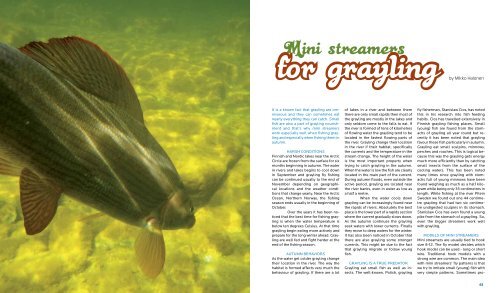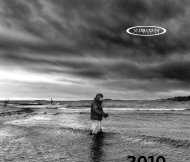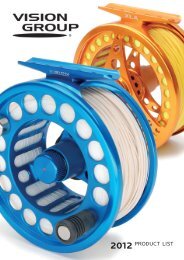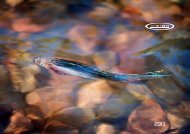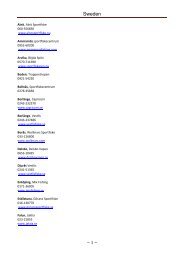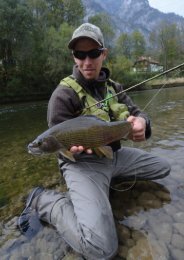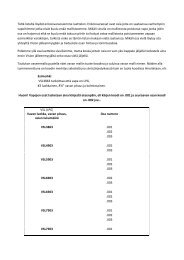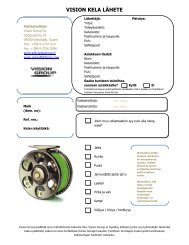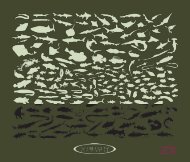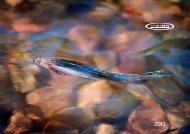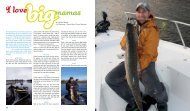Create successful ePaper yourself
Turn your PDF publications into a flip-book with our unique Google optimized e-Paper software.
MODELS OF MINI STREAMERS<br />
Mini streamers are usually tied to hook<br />
size 8-12. The fly model decides which<br />
hook model can be used - long or short<br />
wire. Traditional hook models with a<br />
strong wire are common. The main idea<br />
with mini streamers’ fly patterns is that<br />
we try to imitate small (young) fish with<br />
very simple patterns. Sometimes <strong>proby</strong><br />
Mikko Halonen<br />
It is a known fact that grayling are omnivorous<br />
and they can sometimes eat<br />
nearly everything they can catch. Small<br />
fish are also a part of grayling nourishment<br />
and that’s why mini streamers<br />
work especially well when fishing grayling<br />
and especially when fishing them in<br />
autumn.<br />
HARSH CONDITIONS<br />
Finnish and Nordic lakes near the Arctic<br />
Circle are frozen from the surface for six<br />
months beginning in autumn. The water<br />
in rivers and lakes begins to cool down<br />
in September and grayling fly fishing<br />
can be continued usually to the end of<br />
November depending on geographical<br />
locations and the weather conditions<br />
that change yearly. Near the Arctic<br />
Ocean, Northern Norway, the fishing<br />
season ends usually in the beginning of<br />
October.<br />
Over the years it has been noticed<br />
that the best time for fishing grayling<br />
is when the water temperature is<br />
below ten degrees Celsius. At that time<br />
grayling begin eating more actively and<br />
prepare for the long winter ahead. Grayling<br />
are well fed and fight harder at the<br />
end of the fishing season.<br />
AUTUMN BEHAVIORS<br />
As the water get colder grayling change<br />
their location in the river. The way the<br />
habitat is formed affects very much the<br />
behaviour of grayling. If there are a lot<br />
of lakes in a river and between them<br />
there are only small rapids then most of<br />
the grayling are mostly in the lakes and<br />
only seldom come to the falls to eat. If<br />
the river is formed of tens of kilometres<br />
of flowing water the grayling tend to be<br />
located in the fastest flowing parts of<br />
the river. Grayling change their location<br />
in the river if their habitat, specifically<br />
the currents and the temperature in the<br />
stream change. The height of the water<br />
is the most important property when<br />
trying to catch grayling in the autumn.<br />
When the water is low the fish are clearly<br />
located in the main part of the current.<br />
During autumn floods, even outside the<br />
active period, grayling are located near<br />
the river banks, even in water as low as<br />
a half a metre.<br />
When the water cools down<br />
grayling can be increasingly found near<br />
the rapids of rivers. Absolutely the best<br />
place is the lower part of a rapids section<br />
where the current gradually slows down.<br />
As the autumn continues the grayling<br />
seek waters with lower currents. Finally<br />
they move to deep waters for the winter.<br />
It has also been noticed in October that<br />
there are also grayling some stronger<br />
currents. This might be due to the fact<br />
that grayling migrate or follow young<br />
fish.<br />
GRAYLING IS A TRUE PREDATOR<br />
Grayling eat small fish as well as insects.<br />
The well-known, Polish, grayling<br />
fly fisherman, Stanislaw Cios, has noted<br />
this in his research into fish feeding<br />
habits. Cios has travelled extensively in<br />
Finnish grayling fishing places. Small<br />
(young) fish are found from the stomachs<br />
of grayling all year round but recently<br />
it has been noted that grayling<br />
favour these fish particularly in autumn.<br />
Grayling eat small sculpins, minnows,<br />
perches and roaches. This is logical because<br />
this way the grayling gets energy<br />
much more efficiently than by catching<br />
small insects from the surface of the<br />
cooling waters. This has been noted<br />
many times since grayling with stomachs<br />
full of young minnows have been<br />
found weighing as much as a half kilogram<br />
while being only 35 centimetres in<br />
length. While fishing at the river Pitein<br />
Sweden we found out one 44 centimetre<br />
grayling that had two six centimetre<br />
undigested sculpins in its stomach.<br />
Stanislaw Cios has even found a young<br />
pike from the stomach of a grayling. So,<br />
even the bigger streamers work well<br />
with grayling.<br />
40 41
By Mikko Halonen<br />
vocatively coloured models are much<br />
more effective than exact imitations. A<br />
very important thing is also the shape<br />
and liveliness of patterns. This must<br />
be kept in mind when you are tying and<br />
thinking about which materials to use.<br />
Materials make your fly come to life.<br />
Along with the naturally coloured<br />
mini streamers, different kinds of<br />
blue, red, orange, purple, white, black<br />
and brown tones work as well. It has<br />
been noted that the colours that fish<br />
like best change nearly yearly. Later in<br />
the autumn darker colours work better.<br />
Often it is good to have a clear strike<br />
point on the body or on the wing of the<br />
fly. Some glimmer can also be added to<br />
the wings. Also the clarity of the waters<br />
affect the colour tone of the flies. The<br />
ties can be weighted but it is better to<br />
use external lead weights with these<br />
flies. Weighting the ties weakens the<br />
lively character of the flies.<br />
ABOUT THE FISHING TECHNIQUE<br />
When fishing with mini streamers it is<br />
always better to use two or three flies at<br />
a time. By using different colour combinations<br />
one can easily bracket the best<br />
colour for the situation. It is recommended<br />
to change fishing techniques<br />
when using mini streamers because<br />
grayling seem to change their eating<br />
habits in the autumn when the days<br />
become shorter. A floating or intermediate<br />
line at the most is sufficient. It is<br />
important to have the streamer clearly<br />
under the surface. If the grayling are not<br />
found in the intermediate waters one<br />
should start bracketing the different<br />
depths of water by adding weight to the<br />
fly. The grayling eat from the bottom of<br />
the stream at times so then the fly must<br />
be delivered there with the help of additional<br />
weight. Repetition increases effectiveness<br />
so when you find good places<br />
for fishing you should take advantage<br />
of them. Where you can find one grayling<br />
you can definitely find more.<br />
The fishing location affects the choice<br />
of fishing technique. The traditional wet<br />
fly technique (dead-drift) where the fly<br />
is cast diagonally downstream and is<br />
carried by the stream works when fishing<br />
intermediate waters. When the fly is<br />
carried freely in the stream it is possible<br />
to make small lifts, just when the fly<br />
comes to the edge of the current. The<br />
hand twist technique is worth trying and<br />
the rod can be slightly nodded multiple<br />
times in addition. On the other hand<br />
the classic nymph fishing technique<br />
where the fly is cast upstream and is either<br />
controlled of carried freely by the<br />
stream can be used. The rolling nymph<br />
technique is one of the most effective<br />
when using mini streamers and fishing<br />
the edges of the stream. Diagonal<br />
movement of flies works well upstream.<br />
When fishing the calm lower part of<br />
rapid, an effective method is to let the<br />
fly be still when floating downstream<br />
quickly, and then make small movements<br />
near the surface when the fly is<br />
right on a slow flowing location such as<br />
by a boulder. The small vibration from<br />
the fly sometimes activates the grayling<br />
to strike. Later in the autumn the flies’<br />
movements have to be calmer.<br />
TRY THEM<br />
No exact directions can be given for the<br />
best fishing times of the day. In September<br />
the best times for fishing are one to<br />
two hours before complete darkness.<br />
The afternoon can also prove productive.<br />
In October grayling are very active<br />
around sunrise. Later in the year the active<br />
time is nearer the middle of the day.<br />
So the shorter the day gets the earlier<br />
you should go fishing. Wherever and<br />
whenever you have grayling in Europe a<br />
streamer can and should be tried.<br />
See pro-flyfishing.fi<br />
River Teno’s Mini Streamer<br />
Hook: 10-12, Kamasan B175<br />
Rib: fine copper oval<br />
Body: 1/4 fiery claret SLF (#13) and 3/4<br />
black wool dubbed<br />
Wing: brown-black Arctic Fox tail, 4 fibre<br />
of Pearl Flashabou<br />
Head: dark grey Arctic Fox Tail fur<br />
dubbed and brushed<br />
Mantissa Bleak<br />
Hook: 8, TMC 9395<br />
Tail: light brown bear fur / squirrel<br />
Under body: wool<br />
Body: flat silver mylar tubing<br />
Wing: black marabou<br />
Sides: fiery claret (#13) SLF dubbing<br />
Throat Hackle: white squirrel fur or Arctic<br />
Fox fur<br />
Head: grey squirrel fur dubbed (fur<br />
chenille dubbing loop method) and<br />
brushed<br />
River Konkamaeno’s Mini Streamer<br />
Hook: 10-14, Kamasan B175<br />
Body: black wool<br />
Wing: brown-black Arctic Fox tail, 4 fibre<br />
of Peacock Crystal Hair<br />
Throat Hackle: few fibers turquoise blue<br />
cock hackle<br />
Head: dark grey Arctic Fox Tail fur<br />
dubbed and brushed<br />
42 43
VECTOR JACKET<br />
POWER HOODIE<br />
NITE REEL<br />
MAG ROD<br />
ATTACK FLY LINE<br />
11.<br />
7.<br />
1.<br />
9.<br />
3.<br />
3.<br />
8.<br />
10.<br />
4.<br />
2.<br />
5.<br />
6.<br />
HOPPER SHOES<br />
1. Mako wading shoes, 2. Kura waders, 3. Kura wading jacket, 4. Gt four rod, 5. Cdc reel, 6. Vibe 125 flyline, 7. Micro Hoodie,<br />
8. Mega Bra, 9. Nano mono tippet, 10. Vision trout net (brown chassis and black net), 11.“Grey beanie”.<br />
44 45


